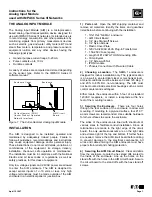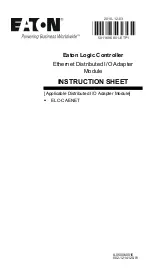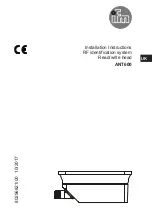
5 BBL Single Wall Hybrid Brewhouse V6
© Blichmann Engineering, LLC 2022
For replacement parts, visit: blichmannengineering.com/genuine-replacement-parts
12
When the temperature has been reached and you are ready to pump liquor to the MT turn the PID selector switch to OFF. Underlet water into the MT by
pumping water from the HLT into the BOTTOM of the MT. When you have 3-4” of water above the false bottom begin adding and stirring the malt as you
continue to pump.
TIP:
we recommend underletting so that the malt and water combine and reach close to your desired rest temperature at all times. It takes 15-20 min to
stir in all the malt and conversion does begin quickly. If you were to fill the MT with all the hot liquor and then add the malt you would over-shoot your
infusion temperature for the first 15-20 minutes until you had all the malt in the MT. Therefore underletting is highly advised. Having one person stir
while another adds malt is very helpful.
Your mash tun, even though uninsulated, will lose less than 1 F/hr. Rarely do commercial breweries perform step mashing. Modern malts are highly
modified and very little is to be gained by step mashing. Homebrew kettles, on the other hand, are so small that they lose heat quickly so temperature
maintenance is common (RIMS/HERMS).
After your scarification rest period, vorlauf (recirculate) your wort for about 10 minutes to clarify the wort and set the grain bed in preparation for runoff to
the BK. Now is a good time to check that you have your stand pipe installed in your boil kettle as detailed previously.
Lautering (sparging) and vorlauf are both performed using the CIP ball included with the system to gently distribute liquor or wort over the top of the
grain bed. See the image below. Take care to avoid too fast of a runoff which may stick the mash. Note that the level gauge also acts as a manometer
that measures the suction pressure on the grain bed. If the level in the gauge is more than 1/3 lower than the level in the tank you are drawing too quickly
and will soon stick your mash. In general, you want to lauter your mash for 45 -60 min for optimum efficiency. Stop runoff when your runnings are below
1.010 SG (2.5 deg Plato) or when your runnings reach 6 pH.
IMPORTANT:
Do NOT sparge or vorlauf at full pump flow or you are very likely to stick your mash, and your efficiency will suffer severely!
TIP:
Your pumps are equipped with sanitary diaphragm valves that make easy work of balancing your flow rates. After a few brews you will determine
the number of turns on the valve to achieve your desired flow. Simply make the same number of turns on each pump and your flows will be very close to
balanced.
BREWHOUSE OPERATION
HEATING HOT LIQUOR
MASH OPERATION
The hybrid design combines the conveniences of a traditional brewhouse with the simplicity, familiarity, and lower start-up cost of a homebrew system.
This allows a fast and easy transition into commercial brewing with very few sacrifices! As such, startup and the learning curve is quite simple. This
system is a fly-sparge design and includes a boil kettle, a hot liquor tank, and a mash/lauter tun. Note that the boil kettle and HLT are identical kettles for
convenience. Both contain a whirlpool port. For the HLT, simply cap the whirlpool port with the included fittings.
IMPORTANT:
This manual is not intended as a brewing guide. If you are not intimately familiar with all grain brewing techniques we highly recommend
the following texts from the Brewers Association:
How to Brew (Palmer)
Water (Palmer & Kaminski)
Yeast (Zainasheff and White)
Malt (John Mallet)
For the Love of Hops (Stan Hieronymus)
Brewing Classic Beer Styles (Zainasheff & Palmer)
For a typical brew day you will fill your HLT with enough water for your full brew length. Always better to have too much hot liquor than too little! For
higher gravity beers it may be necessary to add more liquor to your HLT after dough-in. Or simply heat your strike water in your boil kettle, and separately
heat your sparge water in your HLT. It is really a matter of preference.
TIP:
For recipe calculation and strike water temps we have loaded the 3.5 BBL kettles into BeerSmith. We highly recommend this software for all of your
brews. It will take a few brews to dial in all of your parameters to achieve consistent results.
CAUTION:
prior to powering up your panel, or pulling the emergency stop switch to the ON position, turn all heater control selector switches to OFF!
This will prevent unintended energizing of the heating elements. ALWAYS be in the habit of turning the heater power selector switches to OFF prior
to draining any kettle! Fill your HLT and (and/or boil kettle) with the desired amount of water ensuring that there is enough water to actuate the float
switches. If the switches are not floating they will not allow the heaters to energize!
Set your strike water to the desired temperature. Remember to press the enter key to accept the new value. If the screen is flashing the new setting has
NOT been accepted.


































